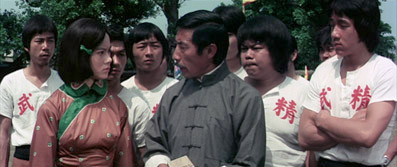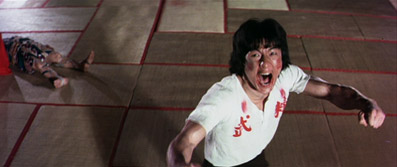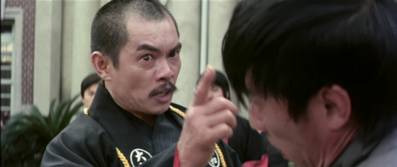|
There can't be a martial arts movie fan alive who doesn't
know Fist of Fury, the second starring
vehicle for Bruce Lee and the one that really confirmed
him as a genre superstar. And there can also be precious
few who did not know that following Lee's death, a whole
string of fighters were built up and promoted as his successor,
only to then fade into action cinema oblivion. Fortunately
for us genre fans, one of them did not. His name, of course,
was Jackie Chan.
New
Fist of Fury was probably the most blatant attempt
to establish Chan as the new Bruce Lee and contains a number
of deliberate and obvious similarities to its illustrious
predecessor. Set in Japanese occupied Taiwan, it once again
casts the Japanese as the brutal and bullying bad guys and
the Chinese locals as the very essence of noble resistance.
It includes a Japanese fuelled rivalry between two martial arts schools,
some symbolic sign smashing, and has an ending that
could be read as making a historical-political point, but is
far more likely to have been driven by the perceived need
to recycle but still top the memorable final freeze frame
of its predecessor. Other Lee films are also referenced,
with Chan's character reluctantly drawn into a battle that
he eventually leads, recalling a similar set-up in The
Big Boss, and the three parallel cuts he collects
on his cheek during the final fight deliberately echo an
iconic image of Lee from Enter the Dragon.

Chan
(or as he's named here, Jackie Chen) plays Ah Loong, a thief
who repeatedly walks into trouble with the occupying Japanese,
whom he despises. His contempt extends to anyone who collaborates
with them, little realising that his estranged mother is
working as a prostitute in their service. His refusal to work for the
self-important Ling at the DaYang Gate school (actually
a gang of criminals, as the non-honourable schools tend
to be in these films) is driven in part by their close association
with the foreign invaders, though the reason he gives is
that he is uninterested in learning kung-fu, apparently
because of the rules and the discipline that this involves. He could
do with learning a bit, though, as he's always getting into
fights, and despite a flailing enthusiasm and luck of a
Tekken newcomer, he invariable gets the crap kicked
out of him. When one of his attempts at theft backfires on him, he is introduced to pretty newcomer to the area Li-Er, who takes a liking
to him and offers to teach him kung-fu, but he's still having
none of it. Li-Er's grandfather is respected martial arts
teacher Elder Xu, and when he dies (in a particularly odd
manner) after confronting the evil minded Okimura and his
hard-arsed bodyguard daughter, she establishes her own kung-fu
school, named Jing Wu, but quickly runs foul first of Ling
and his DaYang Gate boys, then Okimura and his crew. When
the remnants of the smashed-up Jing Wu school sign are dumped
in the town square, it's too much for Ah Loong, who leads
a procession to the school to enrol, and in the blink of
an eye has become a kung fu demon capable to taking on just
about anyone who crosses his sense of honour and decency.
OK,
maybe I'm getting a little flip towards the end there, but
it's hard not to be. Even by martial arts
film standards, this is by the clunkiest of numbers, lacking any of the narrative complexity
of other early Chan films or their action quota and inventive
choreography. The fights here are fast and brutal when they
come, but there is little of the creative acrobatics and
can't-believe-it moves for which Chan was later to become
renowned. He's also strangely and frustratingly under-used. Getting halfway into the film before allowing him to show
his stuff is a tease borrowed directly from The
Big Boss, but after a busy training sequence he
then sits on the sidelines until his final, and formulaic plotting.

Director Lo Wei, who really made his mark with The
Big Boss and the original Fist of Fury,
has caught some fan flack in recent years for
supposedly holding Chan back, and New Fist of Fury
certainly does his case no favours. It's a sub-par martial
arts movie that is too talky and too formulaic and lacks
innovation in every department, and as a vehicle to launch Chan
as the new Bruce Lee it's a botched job in every respect.
But maybe we should take some comfort from that, as it was
only when Chan was able to move out from under Lee's considerable
shadow and develop his own very specific style and screen
persona that he really began to make an impact of his own.
What the studios and some of the filmmakers failed to fully
appreciate at the time was that what genre fans were really
waiting for was not a direct Bruce Lee replacement but something new,
a performer with his own unique way of the fist and feet.
You wouldn't know it from watching New Fist of Fury,
but that star was already up on screen, ready and waiting
to show the world what he could do.
Now
before I move on to the technical specs I do feel the need
to comment on the version of the film included on this Hong
Kong Legends release. You may not agree with me on this
film's merits or otherwise and that's fine, or you may be a Jackie
Chan completist and have been waiting for a decent transfer,
in which case welcome to the club. But before you hand over
your dosh for this disc, be aware that the original running
time of New Fist of Fury is logged at 114
minutes, or 113 in the UK where a small number of cuts were
enforced. The film has been released twice on DVD in the
US, and both the original Beverly Wiltshire 2001 disc (with
a 4:3 cropped picture) and the Sony 2002 release (with the
correct 2.35:1 framing) ran for approximately two hours,
suggesting the inclusion of material not in the original
cut. The print here runs for just 79 minutes, which is 35
minutes shorter than the uncut cinema release and getting
on for 40 minutes shorter than the US DVD releases, allowing
for PAL speed-up. Included as an extra feature is an 8 minute
alternative opening, but stick that on and you're still
talking about a good half-hour of absent material or more,
depending on which cut you're comparing it too. It may well
be that all of the missing footage is more deadly talk,
but I'd like to be in a position of make that judgement
for myself. That lack of extra features on this DVD means
that no explanation for the decision to use this cut of
the film has been supplied. If someone has one, I'd be delighted
to hear from them.
Framed
2.35:1 and anamorphically enhanced, this is another of Hong
Kong Legends' Ultrabit titles and has again been transferred
at a very high bit rate to minimise digital artefacts,
which are almost non-existent. The colours are a little drained,
but otherwise this is a typically clean print with good
detail levels. Contrast is about right, although is a tad
harsh in places, resulting in occasional loss of shadow
detail, and occasionally it feels as if the brightness has
been turned down a notch.

The
usual HKL trilogy of Mandarin mono, Mandarin 5.1 and English
5.1 are present and there's not a lot to choose between
them, although the 5.1 track has a tad more clarity. The
English dub differs from the subtitle translations, with
the repeated and negative (and taken out of context, just
a little racist) references to "the Japs" sometimes
completely absent, so that "You stupid Jap bastards!"
becomes "You bastards!"
Alternate
beginning (8:24)
A sequence set in Shanghai, where Li-Er and her brother and
friend make their plans to travel to Taiwan and continue
the fight against the Japanese and are smuggled onto a boat
by a sympathetic local police inspector. The opening credits
from this version are also included, where Jackie is credited
as Jacky Chan, and followed by the scene used under the
present opening credits, which we now get to hear the dialogue
from. For my money, this is a better opening all round. The
soundtrack is the English dub only.
New
Fist of Fury is lively when the fights kick off
but by the generic numbers and even plodding in-between,
and there's nothing here that genre fans will have not seen elsewhere.
The anti-Japanese element in particular, which you'll find
in several of films of the period (including Fist
of Fury and Hapkido),
is crudely simplistic and doesn't play too comfortably today.
Not one of the lost treasures of Chan's career, but still
of interest to fans, though the severely shortened length of this
version makes it hard to recommend it to anyone but determined
collectors.
|